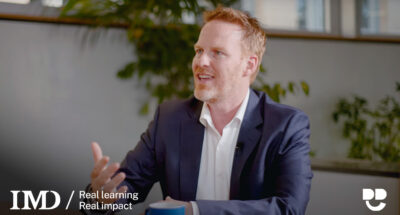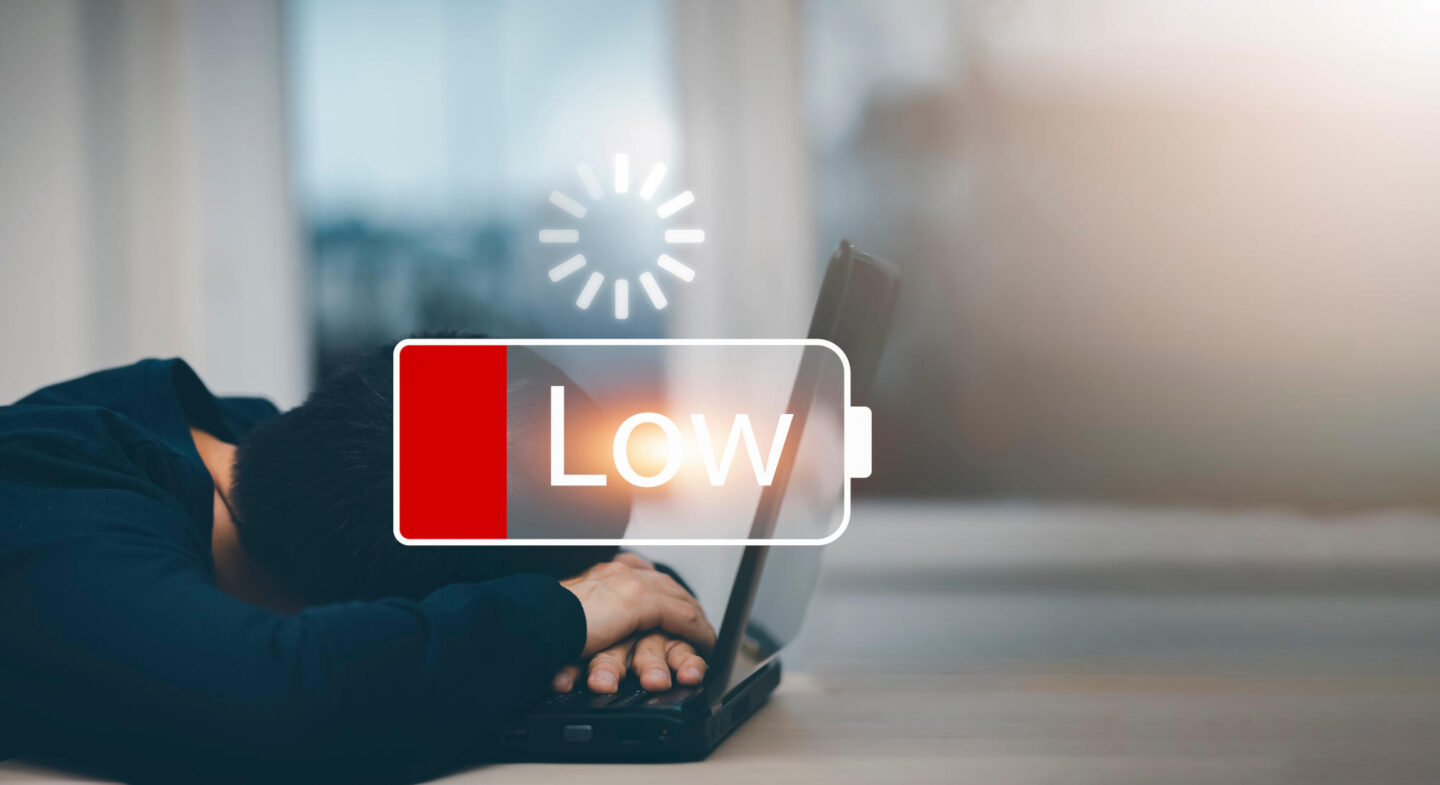
How does sustainable leadership work?
This episode takes you behind the scenes of a recent gathering led by the World Business Council for Sustainable Development together with IMD, where David Bach sat down with two sustainability leaders....

by Merete Wedell-Wedellsborg Published March 11, 2025 in Leadership • 8 min read
“It doesn’t matter what I think,” a client said at the start of our session when I asked how he perceived current global events. He didn’t say what he meant, but he didn’t need to. I have heard this remark many times these last couple of weeks. Many people feel lost, helpless, and exhausted by the relentless cycle of breaking news – so much so that they avoid news altogether.
Others thrive on staying informed and engaged. They feel invigorated by the reordering of geopolitics, even embracing a near-apocalyptic urgency that fuels their engagement and motivation. When German Chancellor-elect Friedrich Merz declared in his speech that Europe could no longer rely on the United States and noted that it was “five minutes to midnight for Europe,” it was a wake-up call – and a jolt of energy for those eager to lift Europe out of complacency.
The start of 2025 has been a moment of reckoning for many leaders and has drawn a line between those who tune in to fight mode and take action and those who lose steam and retrench. How can we strike the right balance of energy? How do we infuse our workdays with vitality and inspiration without feeling overwhelmed by the world around us?
We need an energy first aid kit.

Leaders who are attuned to their organization’s energy can prevent stagnation and ensure team members return home more energized than when they arrived.
We all know the difference between an uninspiring workday and one filled with energy and momentum. These moments signal whether an organization is stuck in the past or marching confidently into the future.
What fuels ambition, accelerates action, and makes time fly? And can we engineer workdays that generate more energy than they consume?

“Stagnation, boredom, and monotony are early warning signs your energy tanks are drained.”
A senior executive once called me after a day of meetings and sighed: “How can something so important feel so dull?” This is the paradox of monotony: high-performing teams that stall, successful companies that drift into complacency, and entire industries trapped in routine.
Stagnation, boredom, and monotony are early warning signs your energy tanks are drained. Psychologically, this inertia signals something deeper: a lack of direction, loss of meaning, unresolved conflicts, and creeping irrelevance. The realization often comes abruptly, prompting the need for an external intervention – a leadership defibrillator to jolt the organization back to life.

Crisis psychology provides a framework for understanding organizational energy. Acute external threats (like the early days of the COVID-19 pandemic, market crashes, and geopolitical shocks) trigger heightened awareness, decisive action, and unity – often energizing teams with clear purpose. However, after the urgency of the outbreak of a crisis, exhaustion sets in, performance dips, and, over time, prolonged, unresolved crises lead to paralysis, division, and disillusion.
The hardest leadership challenge is escaping stagnation without an external shock. In these situations, leaders should reflect on the type of energy they need now. Should you shift your tone, pace, or style? Do you need to turn up the intensity or dial it down? Does this moment call for bold action or calm reflection? A direct confrontation or a strategic retreat? A return to our roots or a leap into the unknown?
Measure progress by what gets done, not what gets discussed.
Leaders can tap into three sustainable sources of energy within their organizations.
When I ask leaders to recall their most rewarding days, they rarely mention victories or celebrations. Instead, they talk about crises – moments when the stakes were high, time was short, and everyone stepped up.
There is power in creating, fighting for something, helping others, and getting things done. Conversely, energy drains away through trivial tasks, pointless meetings, procrastination, empty rhetoric, and endless PowerPoint presentations.
Measure progress by what gets done, not what gets discussed. Patagonia, the outdoor apparel company, doesn’t only track revenue – it measures success by its environmental impact, such as the number of recycled materials used and the repairs made to extend the life of products. This action-oriented focus keeps employees engaged and aligned with the company’s mission. Similarly, the food waste startup Too Good To Go measures success by the number of meals saved daily.
A seasoned board chair once told me, “A good meeting is one where participants leave with more energy than they came in with.” Try monitoring the energy in the room. If a discussion feels lifeless, ask why. Are conflicts being avoided to maintain a superficial harmony? In a psychologically safe space, disagreement can spark new ideas and renewed momentum.
One of the most immediate sources of energy is the team itself. Crisis situations are a unique catalyst for team cohesion and resolve. LEGO takes this insight to heart, encouraging employees to “energize everyone, every day.” To make collaboration more dynamic, they place trays of bricks in meeting rooms, inviting teams to build while they think and discuss.
Team energy is also shaped by presence. Crises cut away the noise and the clutter. Witness the speed at which the EU is cutting red tape and overregulation. This is applicable at the micro-level as well: What distraction can you cut away? Are you fully engaged, or is your phone subtly siphoning attention? Some companies are taking radical steps. Yondr, for example, developed pouches that create phone-free zones, initially for schools but now widely adopted by businesses seeking deeper engagement.
Leaders can also use the clarity and urgency of the situation to band together. One executive I work with conducts an annual “relationship audit,” assessing which colleagues and contacts inspire her and which deplete her energy. Crises are an occasion to do this kind of relationship audit at speed – boosting team energy and rekindling relationships that recharge rather than drain. Revisiting your team’s purpose and set-up can revitalize each team member’s unique contribution.
While crises test our stamina and our convictions, a powerful yet often overlooked energy source lies within our own thoughts, emotions, and unique strengths. For some, renewal comes through silent retreats, digital detoxes, and meditation. For others, it’s boxing, high-intensity workouts, or a square of dark chocolate.
Kevin Kelly, founder of Wired magazine, once reflected on his career and noted, “What made you weird as a kid can make you remarkable as an adult.” Yet, organizations often shy away from personal energy sources, favoring professionalism and conformity over individuality.
NATO’s elite units understand the power of individuality. In high-pressure operations, officers often leverage each soldier’s unique strengths rather than reinforcing a rigid standard. For example, officers encourage soldiers to develop personal rituals for resilience whether through visualization techniques, controlled breathing, or pre-mission routines. These individual practices can be helpful under pressure. Making sure that each soldier is aware of their individual practices, though personal, can enhance team cohesion by ensuring each member brings their best energy to the mission.
Leaders can even adopt this kind of thinking to themselves, and pay attention to their own drivers, triggers, boosters, and accelerators. Allow yourself to break the mold, let your true colors fly, and go into the flow. Crises can be cathartic if you let them.
Liquid Death sells canned water. But its branding – metal-inspired cans, the tagline “Murder Your Thirst,” and an anti-plastic mission – transformed it into a viral sensation. In March 2024, the company secured a valuation of over $1.4bn.
A telling lesson in breaking monotony comes from Liquid Death – a company that turned the world’s dullest beverage into a billion-dollar brand.
Liquid Death sells canned water. But its branding – metal-inspired cans, the tagline “Murder Your Thirst,” and an anti-plastic mission – transformed it into a viral sensation. In March 2024, the company secured a valuation of over $1.4bn.
Organizations rarely collapse with a bang. More often, they decay silently – through a slow, creeping decline marked by uninspired days and unchallenged routines.
The real threat isn’t daily crises; it’s the slow erosion of energy. Beware of excessive professionalism that polishes away passion and personality. Instead, protect and nurture your team’s bold ambitions, constructive tensions, and creative friction.
Leadership in crisis situations is not about managing time and tasks – it’s about managing energy. Learn what fuels your team, what drains them, and how to ignite momentum that spreads across the organization.
Find energy in the now and the new. Let go of the old order and invent the new.
Give energy to others. Take inspiration from LEGO’s “energize everyone, every day.” It’s contagious.
Ask where the spark went. If the room feels flat, something unresolved is lurking beneath the surface. Find it and explore it.
Ditch the dull debates. Some discussions feel tedious because they are – move on to the ones that matter. Cut away the clutter.
Turn on tunnel vision. Like Navy Seals and marathon runners, forget the big picture and the long stretch – take it one step at a time, one minute at a time.
Connect with your convictions. Whether it’s protecting your team, honoring your family, or providing something for yourself, intrinsic motivation fuels resilience.

Adjunct Professor at IMD
Merete Wedell-Wedellsborg is a clinical psychologist who specializes in organizational psychology. As an executive advisor, she has more than two decades of experience developing executive teams and leaders. She runs her own business psychology practice with industry-leading clients in Europe and the US in the financial, pharmaceutical, consumer products and defense sectors, as well as family offices. Merete is the author of the book Battle Mind: How to Navigate in Chaos and Perform Under Pressure.

April 17, 2025 • by David Bach, Felix Zeltner in Leadership
This episode takes you behind the scenes of a recent gathering led by the World Business Council for Sustainable Development together with IMD, where David Bach sat down with two sustainability leaders....

April 17, 2025 • by Michael Skapinker in Leadership
All organizations should have a plan to secure trust during, after (and even before) a crisis hits. Here are a host of examples, good and bad, to learn from....
 Audio available
Audio available
April 15, 2025 • by Knut Haanaes in Leadership
Writing reports that go unread, weekends wasted working on non-essential tasks, and unrealistic targets that can never be met. Top talent is being left exhausted and demoralized. Here are seven ways to...

April 11, 2025 • by Michael D. Watkins in Leadership
Michael Watkins outlines the simultaneous need for acuity and inner rootedness – what he calls Grounded Edge Leadership – to navigate increasing change and uncertainty....
Explore first person business intelligence from top minds curated for a global executive audience